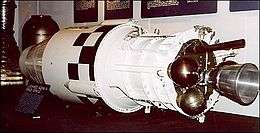Discoverer 9
Discoverer 9 was an American military reconnaissance satellite, launched on 4 February 1960 as a part of the DISCOVERER program, at 18:51:00 GMT, from Vandenberg Air Force Base on the Thor-Agena launch vehicle. The Thor cut off 20 seconds early and left the Agena without sufficient velocity or attitude control. It began tumbling and the engine shut down after only 20 seconds of operation, sending the payload into the Pacific Ocean. At liftoff, an improper disconnect of a pad umbilical also caused a loss of helium pressurization gas in the Agena's propellant tanks.
 An Agena-A stage with Discoverer payload | |
| Mission type | Technology |
|---|---|
| Operator | US Air Force / CIA |
| Harvard designation | 1960-F01 |
| Spacecraft properties | |
| Spacecraft type | CORONA Test Vehicle |
| Bus | Agena-A[1] |
| Launch mass | 779 kg (1,717 lb)[2] |
| Start of mission | |
| Launch date | 2 February 1960, 18:51:45 GMT |
| Rocket | Thor DM-18 Agena-A (Thor 218 - Agena 1052) |
| Launch site | Vandenberg, LC 75-3-4[1] |
A standdown was in effect in CORONA from 20 November 1959 until 4 February 1960 to allow time for intensive R&D efforts to identify and eliminate the causes of failure. DISCOVERER VII through DISCOVERER X carried only a quarter of a load of the film (4.5 kilograms or 9.9 pounds) to permit the carrying of additional instrumentation for testing vehicle performance.[3]
DISCOVERER 9 (NSSDCA ID: DISC9) was a first-generation, low-resolution Air Force surveillance satellite launched from Vandenberg AFB aboard a Thor Agena-A rocket. The mission failed because the satellite never reached orbit.[4]
The DISCOVERER program was managed by the Advanced Research Projects Agency (ARPA) of the Department of Defense and the U.S. Air Force. The primary goal of the program was to develop a film-return photographic surveillance satellite to assess how rapidly the Soviet Union was producing long-range bombers and ballistic missiles and where they were being deployed and to take photos over the Sino-Soviet bloc to replace the U2 spyplanes. It was part of the secret CORONA program which was also used to produce maps and charts for the Department of Defense and other US government mapping programs. The goal of the program was not revealed to the public at the time, it was presented as a program to orbit large satellites to test satellite subsystems and investigate the communication and environmental aspects of placing humans in space, including carrying biological packages for return to Earth from orbit. In all, 38 Discoverer satellites were launched by February 1962, although the satellite reconnaissance program continued until 1972 as the CORONA project. The program documents were declassified in 1995.
References
- McDowell, Jonathan. "Launch Log". Jonathon's Space Report. Retrieved 9 April 2020.
- Wade, Mark. "KH-1". Retrieved 24 April 2020.
- https://www.cia.gov/library/center-for-the-study-of-intelligence/csi-publications/books-and-monographs/corona.pdf - 1995, p. 20
- https://nssdc.gsfc.nasa.gov/nmc/spacecraft/display.action?id=DISC9 - 5 September 2019